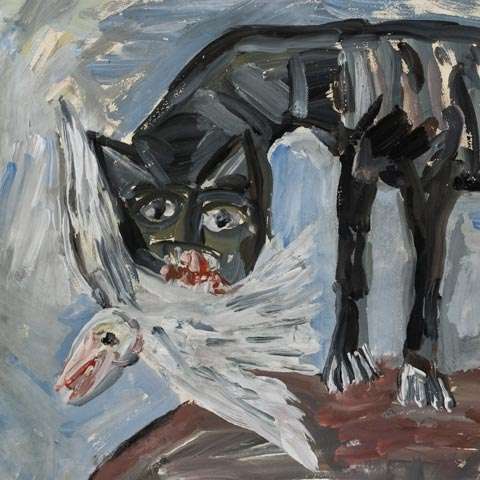
1960s UNOFFICIAL ART
YAKOVLEV Vladimir Igorevich (1934–1998) Cat with a bird. 1974. Paper on hardboard, gouache. 59.5 × 81
“Cat with a bird” is one of the most poignant subjects of Vladimir Yakovlev. In a cat catching a bird, the audience rightly saw a metaphor for the defenselessness of a living being in a harsh world, the cruelty of the confrontation between predator and victim. The subject in itself is philosophical and complex. And in the execution of the mentally ill artist, it acquired a special depth and drama. It is no coincidence that the history of the appearance of Yakovlev's cats eventually began to make legends. Supposedly, the artist once saw a heart-breaking scene with a cat carrying a bird from the window of a psychoneurological clinic or a nursing home — and put it on paper. It is a myth. It was debunked by Yakovlev himself in conversations with people in his inner circle. “Cat with a bird” — is his reading of Picasso's 1939 painting “Cat catching a bird” and other paintings of this cycle. We were told that he had seen the slides or photos in some lectures popular in Soviet times. Or maybe in magazines, or maybe at an imported exhibition at the Pushkin Museum. But the essence is the same. The scene made such a strong impression on him that the artist created his own reinterpretation of the subject. By the way, each cat in Yakovlev's work has its own character. One — with a predatory grin. Another — sad. There are also variants without the bird. The artist returned to the story many times. Cats are, for example, in the collection of Leonid Talochkin, in the collection of Alexander Kronik and in many high-profile collections. But such gouaches are very rare on the market. The chance to buy them does not happen every year. And it's not without reason that collectors continue to hunt for them.
The authenticity of the gouache is confirmed by the expert opinion of Valery Silaev.
BELENOK Petr Ivanovich (1938–1991) The Way to the Light. 1976. Hardboard, mixed media. 164 × 122
The height is one meter sixty-four! 1976! Museum size and a particularly valuable creative period. In the works of the pioneer of panic realism we can usually distinguish several stages of acceptance of the inevitable. But a special layer consists of works with symbols of hope. They are rare. And in front of us is just one of them. “The Way to the Light” is a painting about a glimmer of hope in the abyss of darkness. A portal into another dimension where there is peace, joy and sunshine opens before the participants of the action. That rare case when the artist believes that everything will be well.
Attentive viewers noticed the glued charity ticket of the USSR Children's Fund on the back. It is a beautiful story. Petr Belenok's wife, Iraida Shovkatovna, was a pupil of an orphanage. It was a special subject for her. And as a sign of gratitude, the kind-hearted man Belenok purchased charity tickets for a monstrously large sum for him. That is, in fact, he donated to the orphanages. A beautiful gesture — a good deed with good thoughts. Belenok signed the tickets with his own hand, and these autographs became a kind of souvenir for his friends. And here is one of them the owner of the work mounted on the back.
ZVEREV Anatoly Timofeevich (1931–1986) Portrait of a fair-haired girl. 1965. Paper on hardboard, oil, scratching. 58.5 × 42.5
1965! We present one of Zverev's most beautiful female portraits we have seen over the years. A girl with a pretty face, blonde hair, a long neck, like in the portraits of Jeanne Hébuterne by Modigliani. It is felt that this is a case where Zverev strongly sympathized with the model. The work is virtuosic and light, but at the same time it is multi-faceted. This is not an impetuous sketch. The young and full of vigor artist (Zverev was 34 at the time) spared neither time nor energy. And now we see one of the unconditional creative successes of the famous nonconformist.
NEMUKHIN Vladimir Nikolaevich (1925–2016) Still life with cards. 2007. Canvas, oil, collage. 100 × 100
If you look at the work of Vladimir Nemukhin “technologically” (which we do not like and do not encourage to take as a rule), there is one informal “secret knowledge”. Nemukhin's acquaintances told us that he made small paintings (half a meter or a little more) for a wide circle of collectors. So that as many people as possible could afford them. Even today they can be bought in a relatively affordable range of 250,000–350,000 rubles. But paintings measuring one meter or more in size were originally conceived by him as a museum or the highest collector's level. It is no coincidence that these works are distinguished by a particularly painstaking approach, a high level of technique and effect. And today we present just such a piece — “Still life with cards”. The size is one meter by one meter.
The card theme itself, the suits, the lomber tables interested the artist from an aesthetic point of view, rather than from a gambling point of view. Nemukhin was not a gambler. Cards became his creative toolkit, the same “letters” as the geometric primary symbols in the works of Suprematists. The presented subject was called differently by the artist in different years. It could be “Three decks” or “Game of four hands” — depended on the composition and concept. In this case, one of the possible titles of the work could have been “Green lomber table”. But call it a still life with cards — there would be no mistake.
- Log in to post comments










